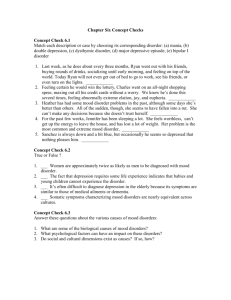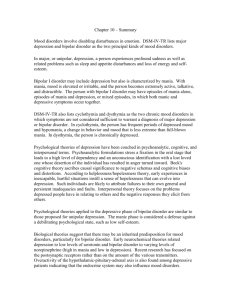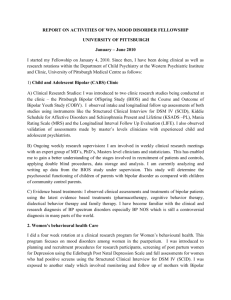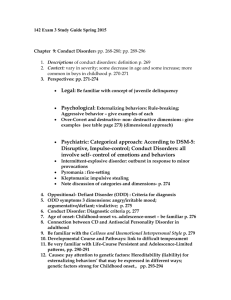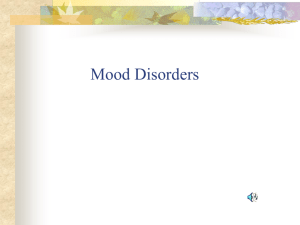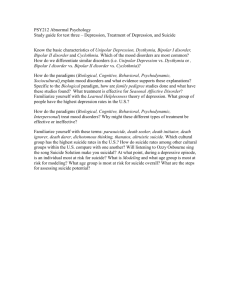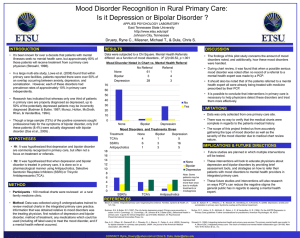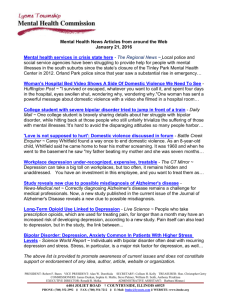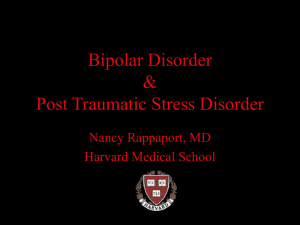Mood Disorders
advertisement
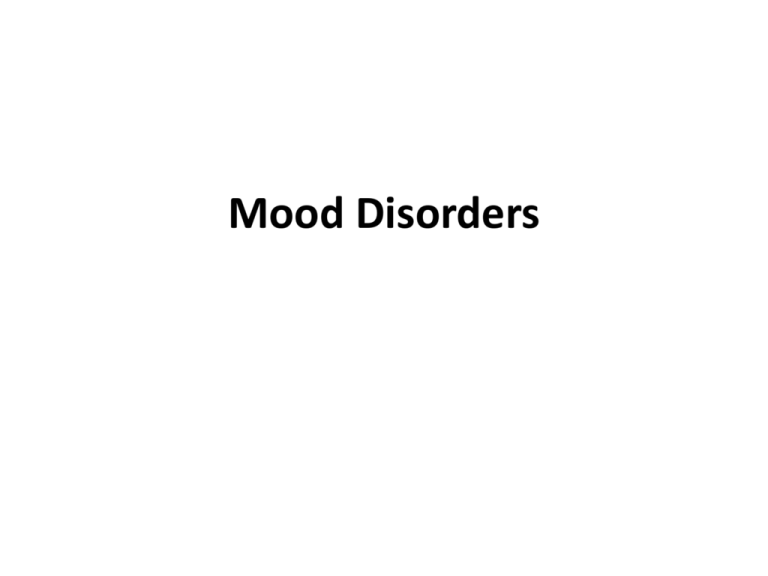
Mood Disorders Mood Disorders • Depression is the oldest and most frequently described psychiatric illness. • Transient symptoms are normal, healthy responses to everyday disappointments in life. • Pathological depression occurs when adaptation is ineffective. Types of Mood Disorders • Depressive Disorders • Bipolar Disorders • Others Depressive Disorders • • • • Major Depressive Disorder Dysthymic Disorder Premenstrual Dysphoric Disorder Bipolar Disorders Other Mood Disorders • Mood disorder due to a general medical condition • Substance-induced mood disorder Bipolar Disorders • Bipolar I Disorder • Bipolar II Disorder • Cyclothymic Disorder Depression: Predisposing Factors • Biological theories – Genetics: – Biochemical influences: Neuroendocrine theories Physiological influences – Psychoanalytical theory • Mourning • Melancholia Learning theory Object loss Cognitive theory Depression: Developmental Implications Childhood Depression • Symptoms: Adolescence • Symptoms include: • Senescence Treatment • Postpartum Depression Treatment Assessment • • • • Transient depression Mild depression Moderate depression Severe depression Nursing Diagnosis Outcome Planning/Implementation Client/Family Education Evaluation Treatment Modalities Antidepressants Newer-generation antidepressants – Selective serotonin reuptake inhibitors (SSRIs) – Second- and third-generation antidepressants • Tricyclic antidepressants • Monoamine oxidase inhibitors (MAOIs) Contraindications/precautions • Contraindications/precautions – Contraindicated in known hypersensitivity (SSRIs, MAOIs, tricyclics); acute phase of recovery from myocardial infarction; angle-closure glaucoma (tricyclics); and concomitant with MAOIs (SSRIs and tricyclics). – Caution with elderly or debilitated clients; clients with hepatic, cardiac, or renal insufficiency; psychotic clients; clients with benign prostatic hypertrophy; and those with history of seizures (tricyclics, MAOIs). Antidepressants- SSRI • Generic Fluoxetine Paroxetine Sertraline Citalopram Escitalopram Fluvoxamine • Brand Prozac Paxil Zoloft Celexa Lexapro Luvox Serotonin Syndrome • • • • Delirium Agitation Tachycardia Sweating Hyperreflexia Muscle spasms Shivering Coarse tremors More severe cases • Hyperthermia Seizures • Renal failure Rhabdomyolysis • Dysrhythmias DIC Antidepressants • Generic Bupropion Mirtzapine Venlafaxine Duloxetine Amitriptyline Imipramine Phenelzine Selegiline • Brand Wellbutrin Remeron Effexor Cymbalta Elavil Tofranil Nardil Emsam Monoamine Oxidase Inhibitor • Nardil • Parnate • Marplan • Selegiline* *Available in a patch form called EMSAM Hypertensive Crisis and Tyramine Bipolar Disorder (Mania) Assessment Stage I—Hypomania Stage II—Acute mania Stage III—Delirious mania Bipolar Disorder (Mania) Childhood and Adolescence • Lifetime prevalence of pediatric and adolescent bipolar disorders is estimated at about 1 percent • Diagnosis is difficult • Guidelines for diagnosis and treatment have been developed by the Child and Adolescent Bipolar Foundation (CABF) Nursing Diagnosis Outcomes Planning/Implementation Client/Family Education Evaluation Psychopharmacology/Mood Stabilzers • Generic Lithum Valproic acid Carbamazepine Oxcarbazepine Lamotrigine Topiramate • Brand Eskalith, Lithobid Depakote, Depakene Tegretol, Equetro Trileptal Lamictal Topamax Planning/Implementation • Blood levels are needed for Lithium (0.41.2mEg/ml) Depakote (4-12 mEg/ml) Tegretol (4-12 meg/ml) • Monitor for side effects of lithium – Drowsiness, dizziness, headache – Dry mouth; thirst; GI upset; nausea/vomiting – Fine hand tremors – Hypotension; arrhythmias, pulse irregularities – Polyuria; dehydration – Weight gain --Potential for toxicity Symbyax is a combination of Prozac an antidepressant and Zyprexa an atypical major tranquilizer. Monitor for side effects of anticonvulsants – – – – – – Nausea and vomiting Drowsiness; dizziness Blood dyscrasias Prolonged bleeding time (with valproic acid) Risk of severe rash (with lamotrigine) Decreased efficacy with oral contraceptives (with topiramate Planning/Implementation (cont.) • Educate client and family about the medication Outcome Criteria/Evaluation

